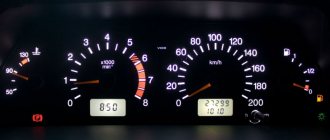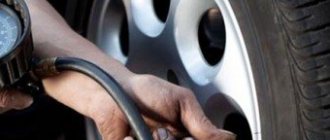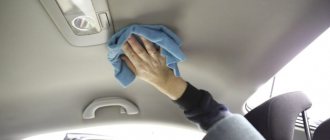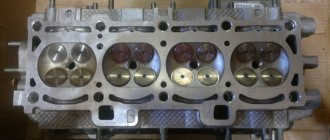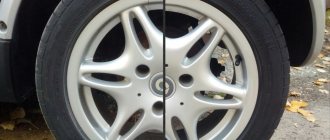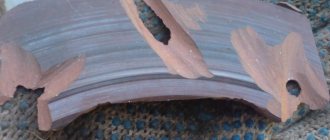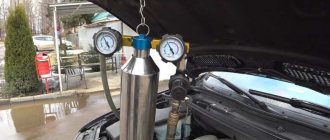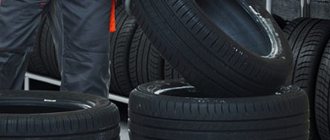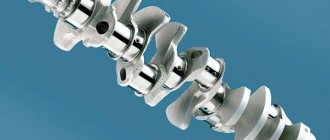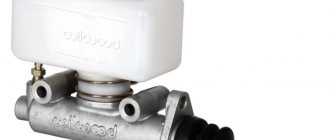A popular procedure among many car enthusiasts, turning brake discs and drums is a good way to extend the life of critical parts.
- Disk deformation due to overheating
- Not an easy task
- Trust but check
Scratches and grooves formed on the working surface of the part affect the operation of the entire braking system. They arise for various reasons. Among the most likely:
- Dirt and foreign objects such as sand, small pebbles, glass shards or metal shavings get into the gap between the friction lining and the disc surface.
- Souring or uneven operation of the cylinders and calipers pressing on the pads.
- Distorted brake pads due to improper installation.
- Poor quality friction lining material.
- Overheating and disk deformation.
- Natural wear of metal due to friction.
- Late replacement of brake pads.
All this is not at all a reason to send expensive components for scrap. Many problems can be avoided if the necessary measures are taken in a timely manner. It is much wiser not to think about how to groove brake discs with your own hands, but to prevent the occurrence of a malfunction.
Entry of dirt and foreign objects
Most often, a problem is signaled by extraneous noises that occur not only during braking, but also when the car is moving in various modes.
It can be either a quiet rustle or a grinding sound that hurts the ear.
When the first suspicions arise, it is worth inspecting the components of the brake system, clearing them of foreign objects and contaminants. In the case of disks, this usually requires blowing out the components with compressed air or removing the foreign object with a screwdriver.
It's more difficult with drums. They definitely have to be removed. If scratches and grooves are found on the metal surface, it means that discs or drums need to be resurfaced. The sooner you do this, the greater the chance of extending the life of the damaged part.
Souring or uneven operation of the cylinders
Souring of calipers and cylinders is a frequently occurring problem associated with damage to the protective boots or the fact that the car has not been used for a long time. In both cases, corrosive damage to the surface of the pistons occurs with the formation of a rather thick layer of oxides on them, which impedes the normal operation of the mechanism. The following steps must be taken:
- Restore the mobility of components by cleaning them from corrosion.
- Replace damaged boots and seals.
But if measures to eliminate the malfunction are taken late, the damage to the working surface of the disk or drum is great, and grooves cannot be avoided.
Grooving brake discs. Video:
About car brake discs
Typically, manufacturers indicate the service life of a particular serviced unit. That is why it makes no sense to talk about specific numbers. On some cars the pads last 10-15 thousand kilometers, on others they last 50 or more. This also applies to disks. If they are of high quality, then they can easily last 100-150 thousand kilometers, provided that the entire system is in good working order. If the caliper guide jams and the pad does not move away from the disc, then it is quite logical that the entire assembly will heat up, and the discs and pads will not only be subject to increased wear, but may also fail due to overheating.
Poor quality friction lining material
When purchasing a set of new brake pads, pay special attention to their quality. It is unacceptable for the friction lining material to contain solid inclusions. Some manufacturers add metal shavings to the mixture, which increases braking efficiency, but accelerates the destruction of discs and makes them wear unevenly. It is better to avoid purchasing such components.
It should be borne in mind that many companies adapt the composition of the friction lining mixture to the composition of the material from which the discs and drums are made. If so, then it makes the most sense to purchase spare parts manufactured by the same company. This way you will ensure optimal operation of the brake system components, extending their service life.
Disk deformation due to overheating
An unpleasant breakdown that results in the car pulling to the side and the brake pedal pulsating when braking. Among the most likely causes of the problem is too intense braking followed by sudden cooling, for example, getting into a puddle.
The stronger the deformation, the less likely it is to fix the problem by turning the disc. Drums are subject to such damage to a much lesser extent.
Natural wear of metal due to friction
Since the dimensions of the friction linings do not completely coincide with the dimensions of the disc or drum, a protruding edge forms on the working surface of the latter over time, interfering with the operation of the brake system components. To remove this edge, you should grind the brake discs , first making sure that they are within the permissible dimensions.
Brake disc groove. Video:
Why do they change or sharpen?
In fact, you can ride these too! BUT it’s not just that you come to the service center and complain that when you press the brake pedal you have:
- The steering wheel hits so hard you can't just hold it
- There is a very strong vibration in the body
- By the way, many people also experience extraneous sounds in the suspension
It is worth noting that they actually last about two to three times when changing the brake linings, and then they need to be changed.
The thing is that with high mileage, the pads fill grooves on the surface of the disc, the sides become non-parallel, and pits and protrusions form. An edge forms on the top of the disc.
Also, temperature changes when you abruptly drive into a puddle can really lead to it, that is, as our common drivers say, “carobit.”
And now, when you press the brake pedal, the pads are pressed against the disc under the influence of the caliper pistons, and all these irregularities are transmitted to the steering wheel or even the suspension and body.
Well, what remains is either to install completely new ones, or to sharpen these old ones, and not much, but to a small size (more on this a little later).
This is interesting: How to make the suspension softer?
Late replacement
When the linings are completely worn out, the friction that occurs between the metal surfaces of the pads and the surfaces of the discs or drums quickly destroys the parts. Some cars are equipped with special wear sensors. If they are not there, you should regularly check the brake system yourself.
Not an easy task
For obvious reasons, many car owners are interested in how to sharpen a brake disc with their own hands. At the risk of disappointing them, we will try to answer honestly. It is impossible to carry out such work without special equipment and certain skills.
You should not try to process the surface of a part whose dimensions must be maintained to within hundredths of a millimeter using sandpaper, much less a file. There are only two options:
- Turn the brake discs on a regular lathe.
- Use special equipment designed to perform this type of work.
Any other processing methods will not give the desired result.
Carrying out work
In contact with the disc, the pad itself wears out and cuts weak grooves on the surface of the disc. Subsequently they become deeper. Due to the fact that the block begins to rub not over its entire working area, but only along the ridges of the cut grooves, the efficiency of the braking system decreases. By removing the ridges, we return a larger contact area, and the quality of braking will improve.
Use of machines
Before grinding a brake disc with your own hands using a special machine, you need to remove the wheel. To do this, jack up the desired side. Next, we connect the rotating part of the equipment to bolts or studs. We attach a working block to the stationary elements of the wheel assembly, which will level the surface.
The entire machine fits on a small trolley, which is convenient to roll to each of the wheels in turn. Working with each wheel takes no more than 10 minutes. PRO-CUT equipment is popular. Processing parameters are controlled using the screen.
The convenience of this method is obvious:
- no need to disassemble much , just remove the wheel;
- the resulting accuracy is comparable to the new factory parameters of runout and surface finish;
- speed of processing and control of the result at any second of the process.
A groove is also used to remove the brake disc. In this case, you will need a special mandrel on which the disk will be based to minimize runout. If everything is done carefully on a lathe, you can do without additional balancing. If the runout is more than 0.1 mm, then re-processing is necessary.
Working with improvised means
For those who do not have the desire or opportunity to carry out processing using a machine, you can use an ordinary file or sharpening stone. It is more convenient to work with a file with the disk removed. The main task is to accurately fix the disc in the yew and control the thickness in the plane being processed. However, this method will give poor results and lead to runout.
A more effective method is to treat a non-removable brake disc. To do this, jack up the desired axle of the car and remove the wheels. We start the car and accelerate in top gear. At the same time, the partner touches the surface of the disc with a file or a coarse-grained sharpening stone.
The method gives less runout than with manual filing. It is worth adjusting the pressure so that it is approximately the same, without allowing the tool to cut deep into the body of the disk. This work takes 20-30 minutes.
After grooving, it is advisable to rinse the surface of the disc with a solvent. It is strictly prohibited to use oil or oily rags for washing, so as not to reduce the coefficient of friction.
Grooving on a lathe
Not everyone can use such equipment. A lathe, which has the necessary accuracy and has dimensions that allow it to process large-diameter parts, sometimes costs more than a car. There is no point in buying it to periodically solve a narrow range of problems.
But even if you have access to equipment with the necessary parameters and you have the appropriate skills, turning brake discs or drums without making special equipment will be impossible.
The fact is that it is impossible to install the part on the machine with the required accuracy simply by spreading the chuck jaws in the central mounting hole. We will have to act differently. Have to:
- Make a special mandrel that matches the shape and size of the wheel hub and has a shank that can be clamped in the chuck. The accuracy of the radial and axial runout of the mandrel should be no more than 0.03 mm.
- Attach the disk or drum to the mandrel (for this you can use the standard fastening system), and then install the mandrel itself into the cartridge.
- Having installed a cutter of a suitable size, groove the working surface of the disk or drum. Runout parameters should not exceed 0.05 mm with surface roughness Rz
In the case of drums, this approach is quite justified. But if we are talking about turning brake discs, then a lathe is not the best way to solve the problem. Fortunately, there are other methods.
About the price
As we have already talked to you, it costs VERY, VERY MUCH to install new ones! For example, for business class it generally costs from 25 to 40,000 for originals. How much will it cost to sharpen? I’ll answer right away - much cheaper, about 4 sometimes 5 times! And if you find a guy who does this for himself, as a “coven”, then you can generally do it for 1500 rubles per pair, this is what my friend did for a CAMRI
There are also two types of grooves:
- With removal, when the entire operation is carried out on the machine
- Without removal, when a special machine with two cutters is attached to the wheel hub and it sharpens the surfaces
If you contact a service station for a process with removal , then it turns out that the average prices are approximately the following:
- Car “A” and “B” class - approximately 3000 - 3500 rubles per pair
- “C” class – 3500 – 4000
- "D" about 5000 - 6000 rubles.
I don’t know about other classes; as a rule, executive cars are serviced with new spare parts.
If we take the process without removal , then the prices are slightly lower, by about 500 - 1000 rubles. It’s like what kind of service will bend you. Why is it cheaper, simply because there is no need to remove the disks and carry them somewhere, put them on machines and stuff the internal “mirror” or as they also call the plane. It’s trivial that all two planes are less of a hassle (I’ll explain a little later).
Groove without removal
Modern industry produces special equipment that makes it possible to perform work directly on the car without removing it. This approach is justified. After all, a wheel hub rotating on bearings certainly provides the necessary conditions for precise machining of the part.
Replacing brake discs. What do you need to know? - there is more useful information here.
Is it worth purchasing a machine for turning brake discs, the cost of which is at least 100 thousand rubles? for your own needs, you will have to decide for yourself. You will have to act in the following order:
- We install the car on a strong and rigid support. A jack will not work here.
- We remove the wheel.
- We dismantle the caliper and clean the disc from foreign contaminants, at the same time making sure that it rotates freely.
- We install a special adapter on the hub and accurately center it, connecting the rest of the equipment to it.
- We position the cutter(s) strictly perpendicular to the wheel axis.
- We turn on the machine and, after waiting until it spins the hub to the required speed, we process the surface of the part.
Taking into account the fact that on most models of this type of machines most of the settings do not take much time, the work is greatly simplified. But, obviously, in the absence of special equipment, the question of how to groove brake discs without removing them with your own hands loses all meaning.
You will be interested in this article - Do-it-yourself repair and replacement of the catalyst.
Trust but check
Taking into account all of the above, it is better to entrust the work to professionals who have the necessary equipment at their disposal. But even here, car owners can expect pitfalls. For example:
- You cannot work on the drive axle of a vehicle without dismantling the part or disconnecting the drive shaft from the wheel. Failure to comply with this rule can lead to breakdown of both the processing machine and the transmission of the machine being serviced.
- To achieve the required roughness parameters of the working surface, the capabilities of an ordinary cutter are quite sufficient. Therefore, the statement that the car will have diamond-cut discs is most likely an attempt to get more money from the owner. There is no real need to use diamond cutters.
- Before starting processing, be sure to make sure that the part is within the acceptable dimensions. Otherwise, you may waste your energy, time and money.
But if you do everything correctly, you can save money by breathing a second life into parts that still retain their service life.
What you can do with your own hands
Now on the Internet there are a lot of videos where “traditional craftsmen” make grooves with their own hands. Oh, as soon as they don’t do it - with a grinder, a file, etc. Some people even make a cut in the middle of the brake pad and insert a piece of sandpaper there.
Guys, it’s VERY DIFFICULT to do exactly with these methods, and even without getting hit! Although, as many say, it’s easy and simple! You may simply ruin discs that can still be sharpened on a machine. Also, if you shoot below the minimum thickness (and this is easy), then it is really dangerous.
Of course, I understand many villagers or residents of small towns, where there are NO normal services. But think for yourself, the brakes are your safety, and it doesn’t cost any money.
Now let's watch a short video version of the article.
I’ll end here, I think my materials were useful. Sincerely yours, AUTOBLOGGER.
(
14 votes, average: 4.93 out of 5)
Similar news
How and with what to paint the calipers. We select the optimal paint and color.
Why doesn't the handbrake hold (the parking brake doesn't work). Basic.
How to change brake pads. We disassemble the front axle + details.
Add a comment Cancel reply
Good day everyone, I decided to write my review of the 2010 Toyota Avensis. Just want…
TOP articles for the month
I have many different articles and videos on various gearboxes, for example here...
I already have an article on the website about choosing memory cards (you can see it here), it’s very...
In the article - is it possible to open windows when the air conditioner is running (you can read it here), I was asked...
Equipment layout
This type of equipment is used to equip specialized car services and service stations. Grooving brake discs is a procedure for removing excess steel to return the part to its original configuration.
Structurally, the machine consists of a processing unit, which includes a power unit and a head with cutters. The latter has the function of displacement relative to the brake disc mounted on the pin. To set the optimal processing mode, the rotation speed of the spindle head can be changed. To increase mobility, many machine models have a movable frame. This makes it possible to process wheels without removing them from the car.
The processing process consists of the following steps.
- Determining the degree of wear of the brake disc. At this stage, it becomes clear whether it is possible to restore the original qualities of the braking system. It is important that the updated brake disc does not negatively affect the safety of the car.
- Setting equipment parameters. In this case, the outer diameter and its mounting dimensions are taken into account. The choice of cutter model depends on the degree of processing.
- Performing a groove. At this stage, it is necessary to control the thickness of the material removed.
- Checking dimensions.
During the grooving process, the surface of the disc may heat up. In this case, it is necessary to use coolant. The optimal system option is to supply coolant through the tool (cutter).
If a machine is used for turning brake discs without removing them from the car, it is important to choose the correct positioning of the processing tool. To do this, the equipment must have local lighting. Measuring tools must be used to control current dimensions.
Comments • 24
But a drawing is possible. Thank you
0.07 is out of tolerance. Tolerance 0.05
See further continuation about this machine. And write comments to me; your opinion as a specialist is very important.
Thanks a lot! Very good device! I will make it as soon as possible!)))) Good luck to you!
Super. I also want to build one))
You had a great idea. We also sharpened the discs on our fielder clip-share.net/video/RkFidW91_dI/video.html
I watched your video on grooving with an angle grinder. Well, let's say knock down the collar. Judging by the appearance, the output is very large. Can these discs be replaced? Take care of yourself and don't forget about other road users. Good luck on the roads!
Start making and selling
As soon as our carriers are completely closed down, I will open production. Having already watched this video, my acquaintances and friends came to see me.
There is also a schoolboy. I'm waiting for a video about the adaptation for it under the disks.
@AvtoBro didn’t know I recently signed up for this and was waiting for it.
clip-share.net/video/zSyG9fjBOIA/video.html here it is. the video came out a long time ago
The cost of turning a disc is 200 rubles. Removes 3 surfaces per installation. There must be absolute rigidity to cut off scorch marks. This also ensures the straightness of the surfaces. I’ll adapt it to the firebox, buy yourself a turning machine 1k62
@Turning Workshop DU, auto repair completely agree.
@man 1377 No one has handled cargo trucks before me, but passenger cars sometimes do, and I consider it a complete freebie. I inserted the disk, set the passage and go smoke, drink coffee to the pleasant rustle of cutting cast iron.
or better yet 1k625 and sharpen drums for trucks, churgyk, churgyk earned twenty rubles.
@AvtoBro sold it in vain, it’s better to find a place to put it. It's everyone's business, of course...
I sold 16k20 Yerevan only because I have nowhere to put it and I have no use for it.
If you do this so that you drag the landing pad under the wheel where the studs are, it will generally be very correct. Well done. And what did he give to his neighbor?
Watch the continuation of this video clip-share.net/video/ZMTuVnN_gI4/video.html
The process itself is normal, but prolonged rotation of one wheel while the other is standing on the drive axle is damaging to the gears and the differential axle, since this unit is not designed for prolonged rotation and high speeds.
if the load is not calculated . and hanging around in the air even without a wheel is really nothing.
Can I buy a machine from you? Are you selling ready-made?
No, I'm not selling. Soon I’ll take a picture of how it works in more detail and how to make it yourself, maybe it will help you. :)
Good afternoon. Is it possible to make something similar to order?
@Evgeny Prokudin Here's everything for you as you wanted clip-share.net/video/ZMTuVnN_gI4/video.html.
I'll probably make a full-length video. On May 10 alone, 8 people asked for drawings and advice on how to make it. I'll try
